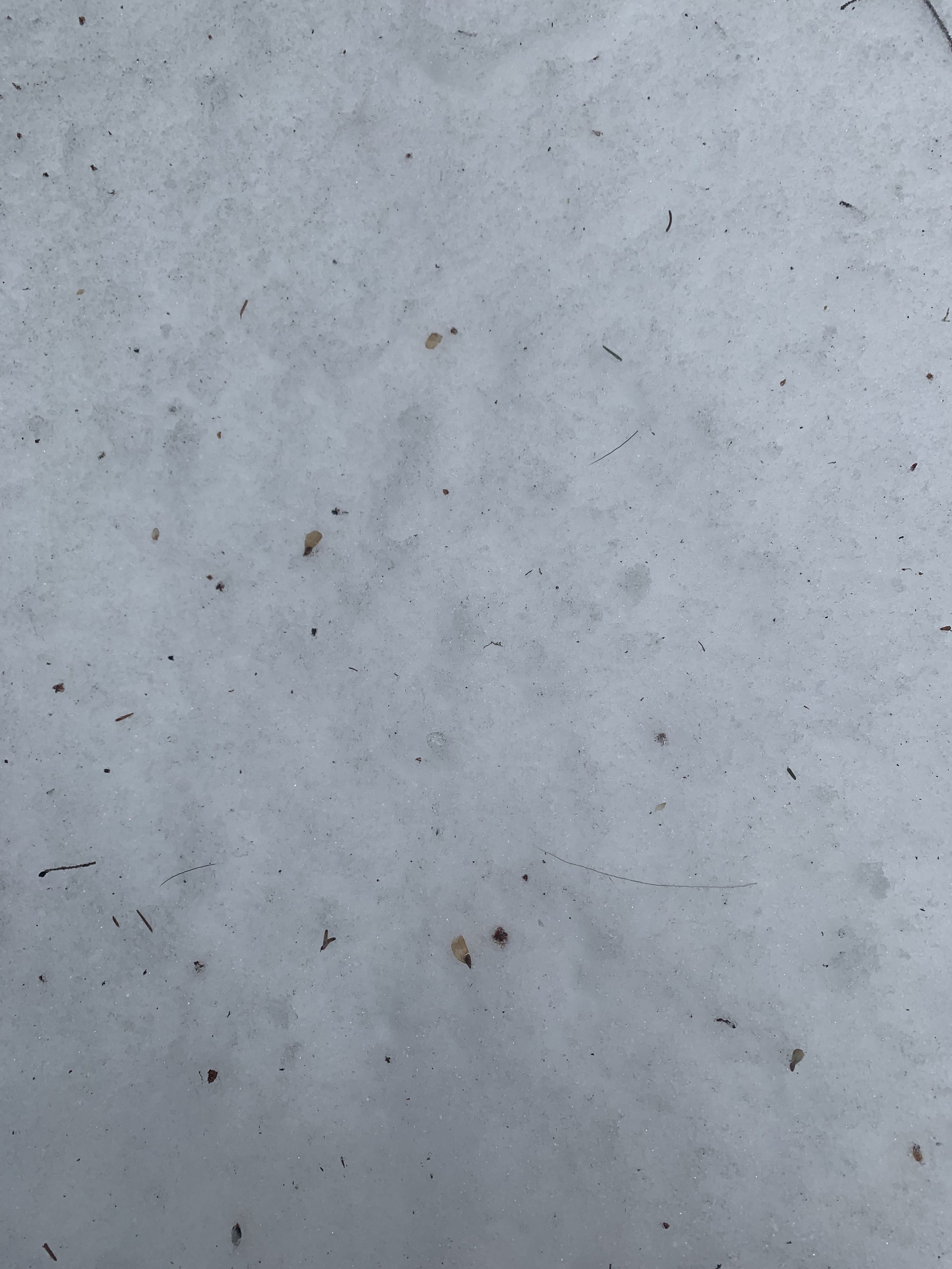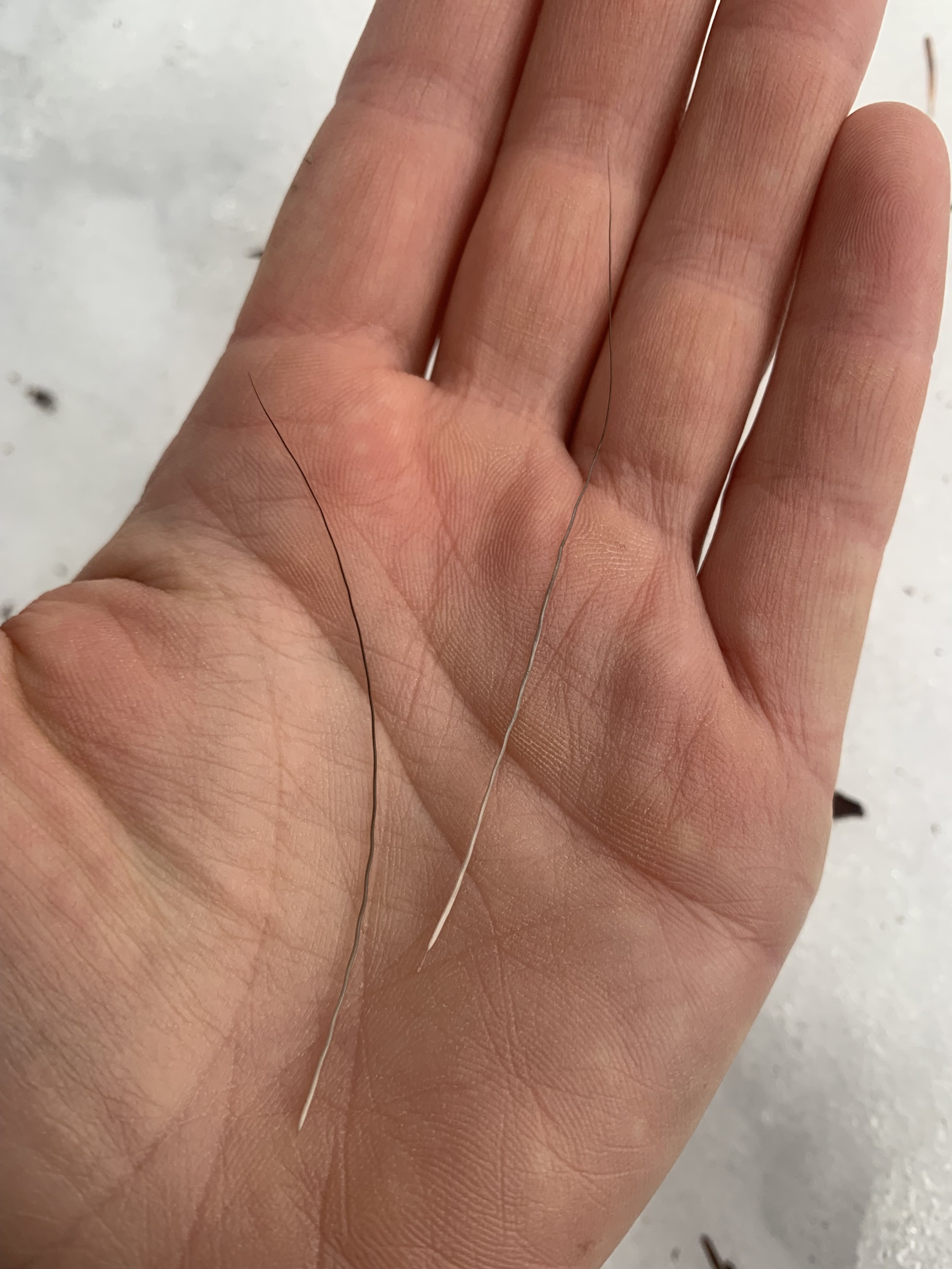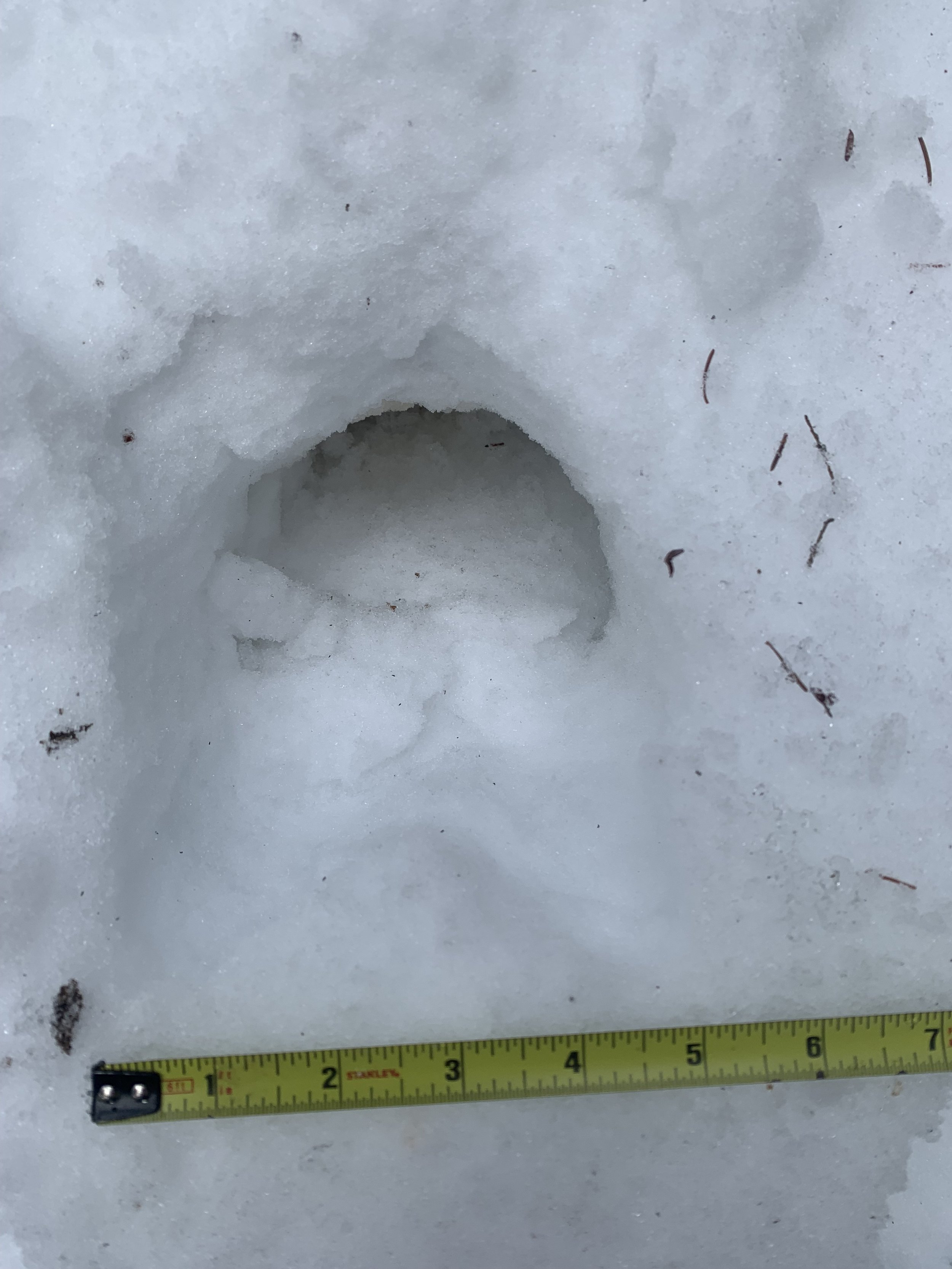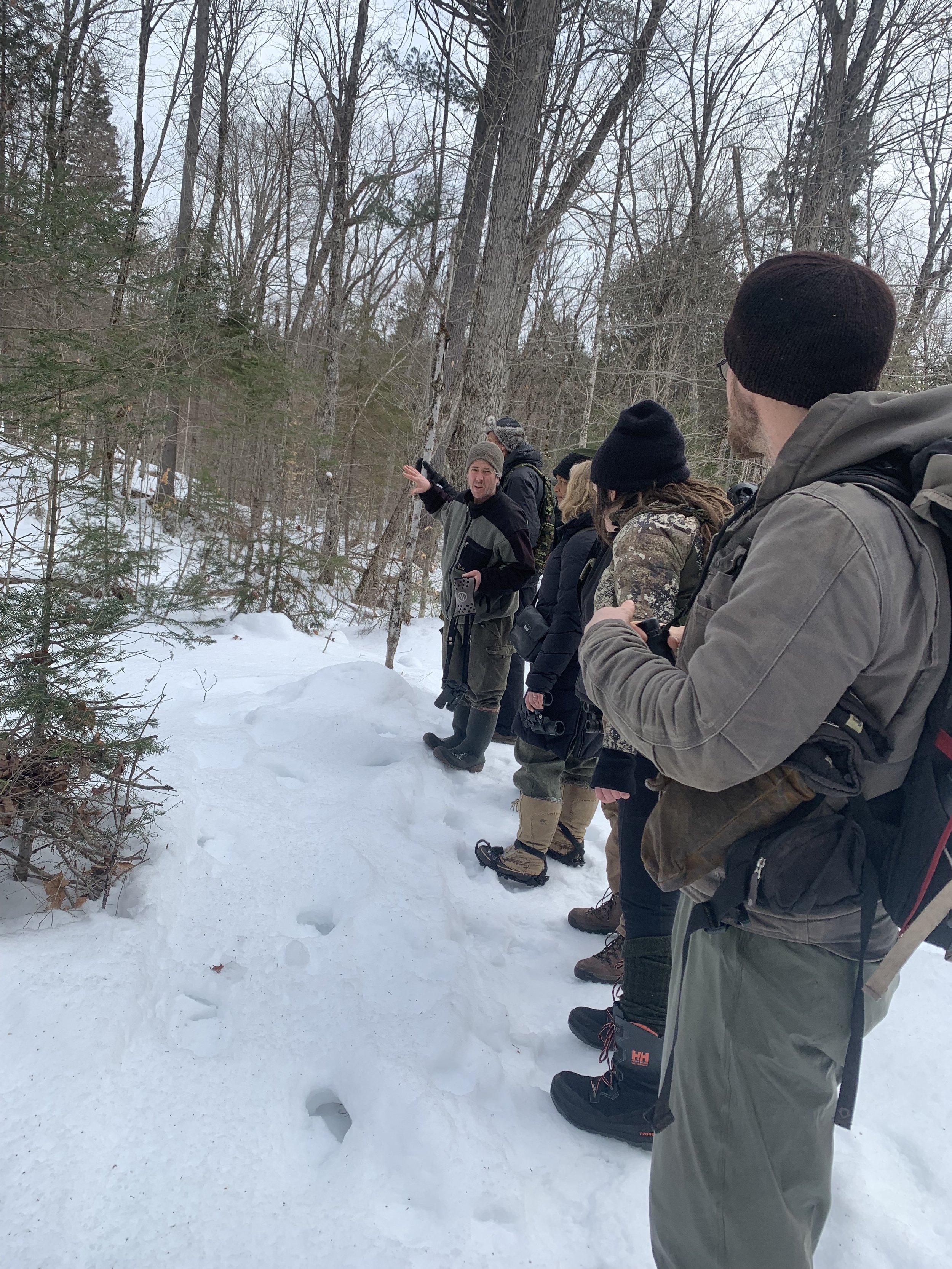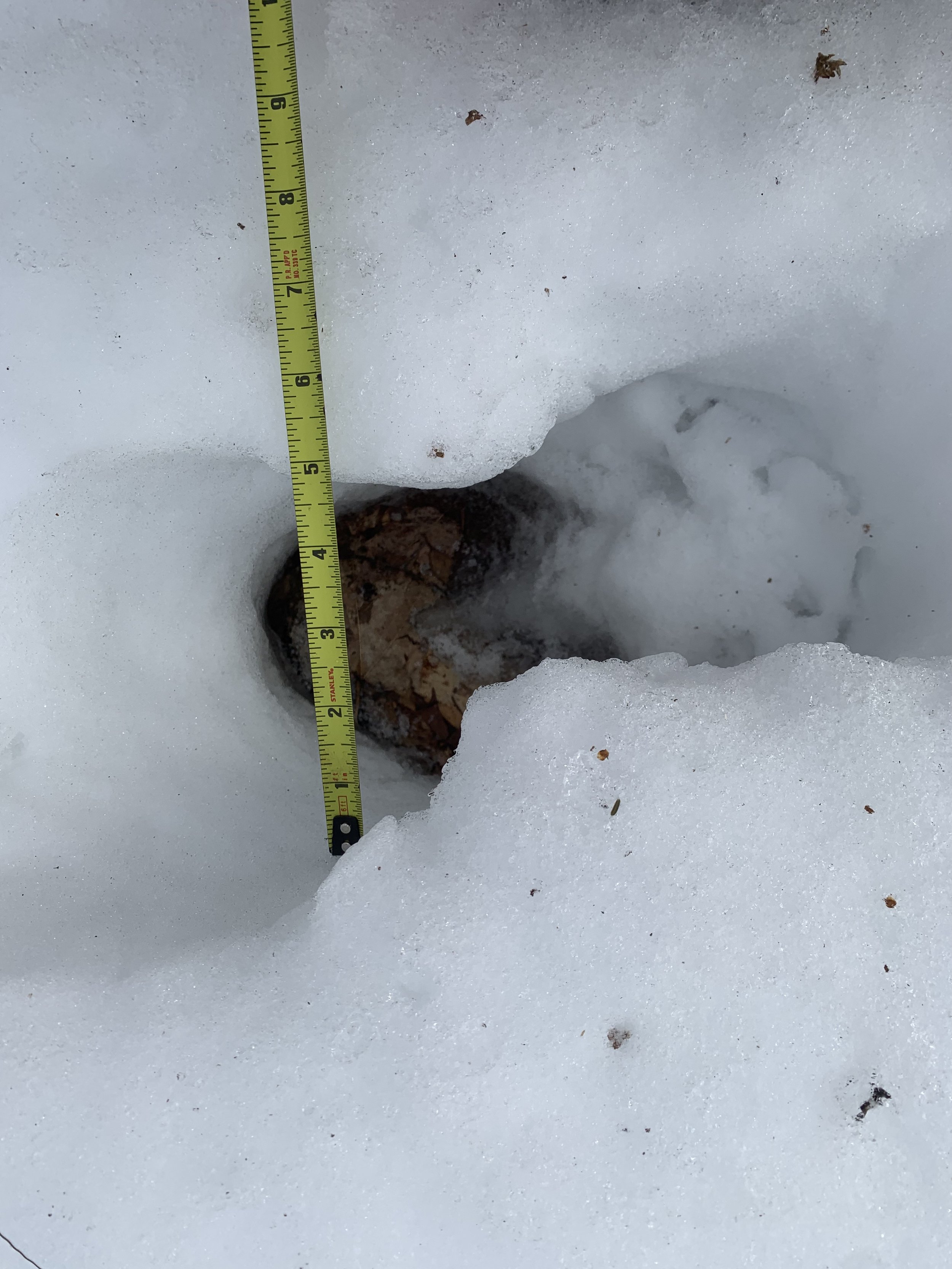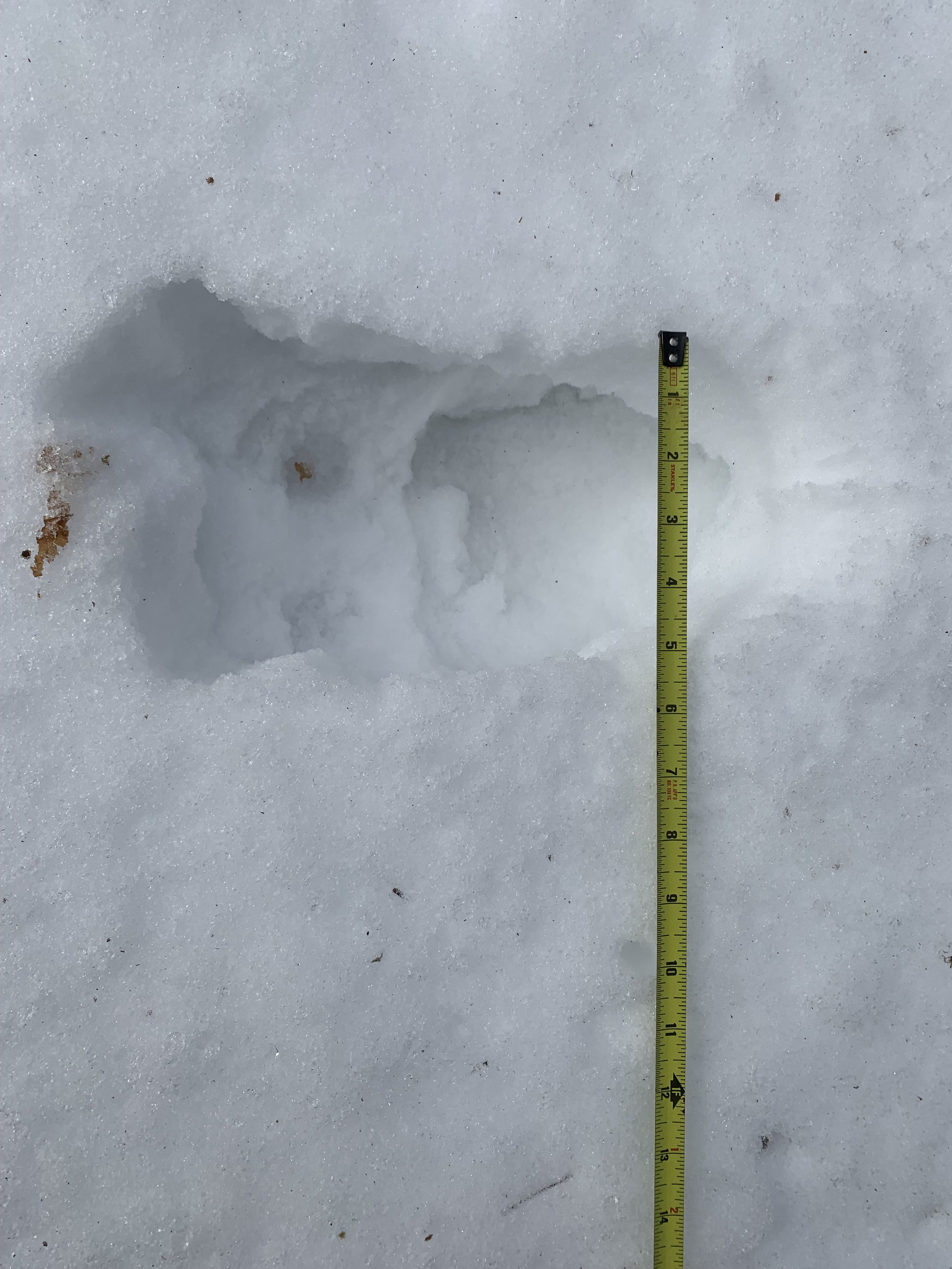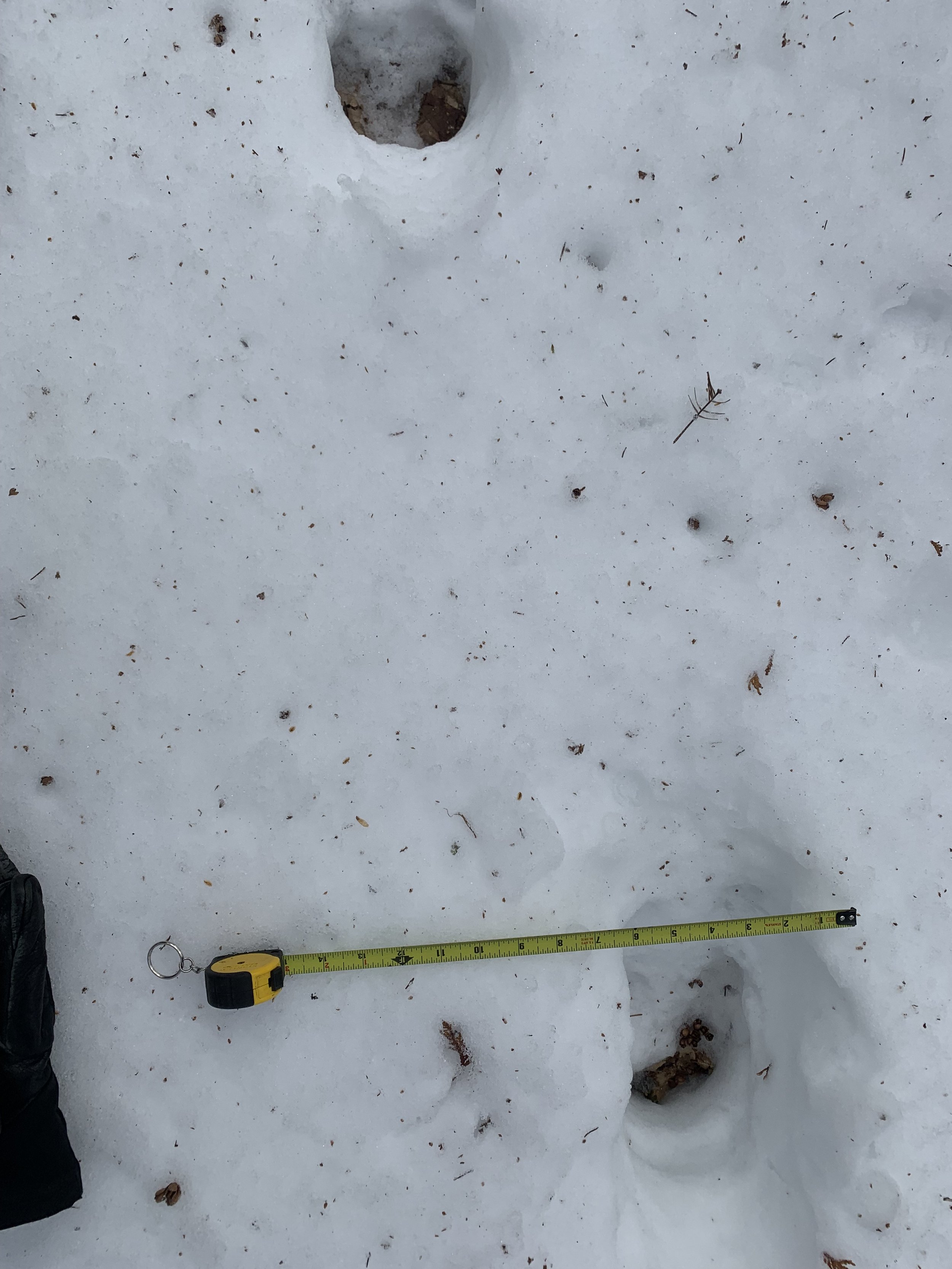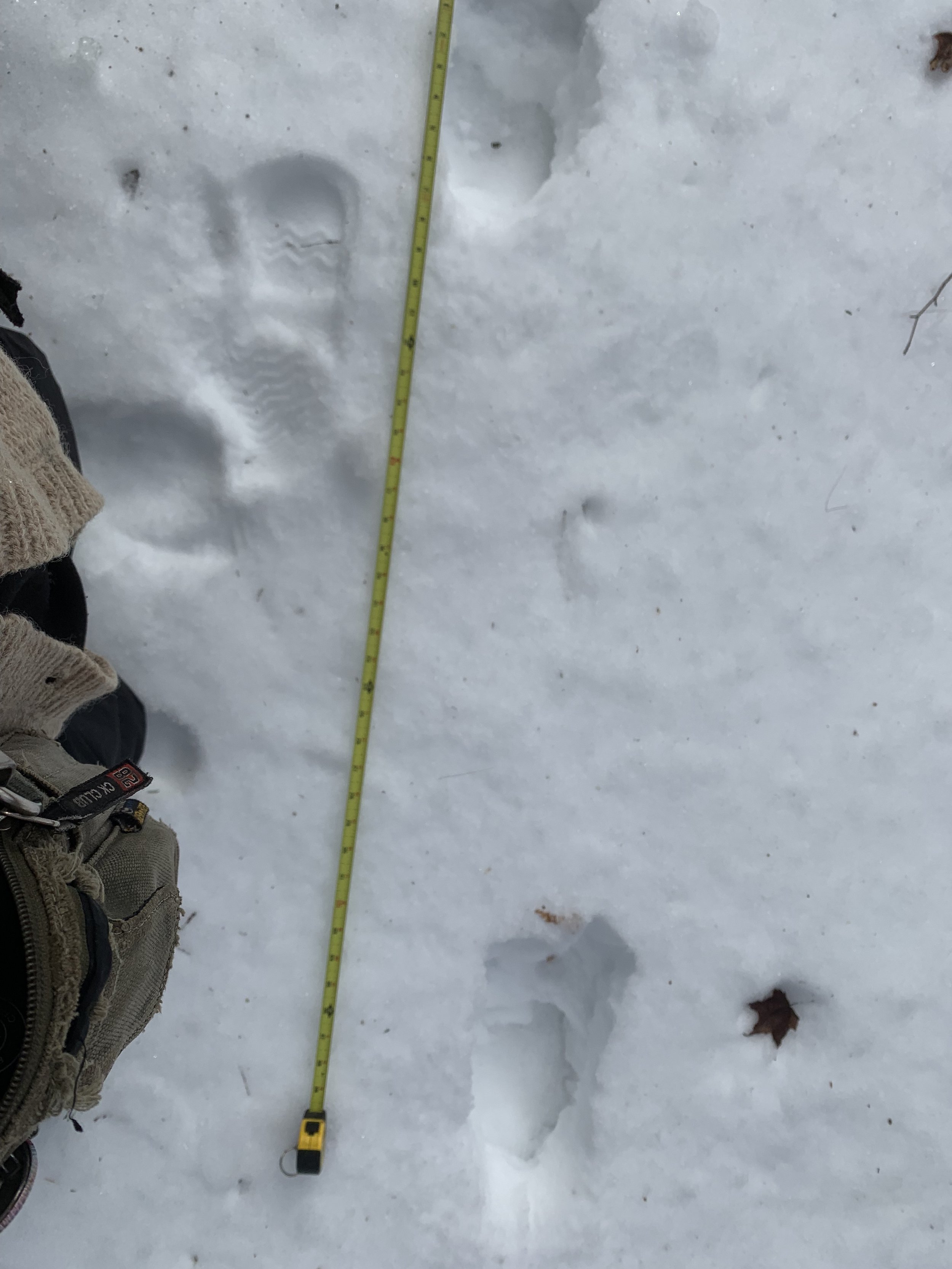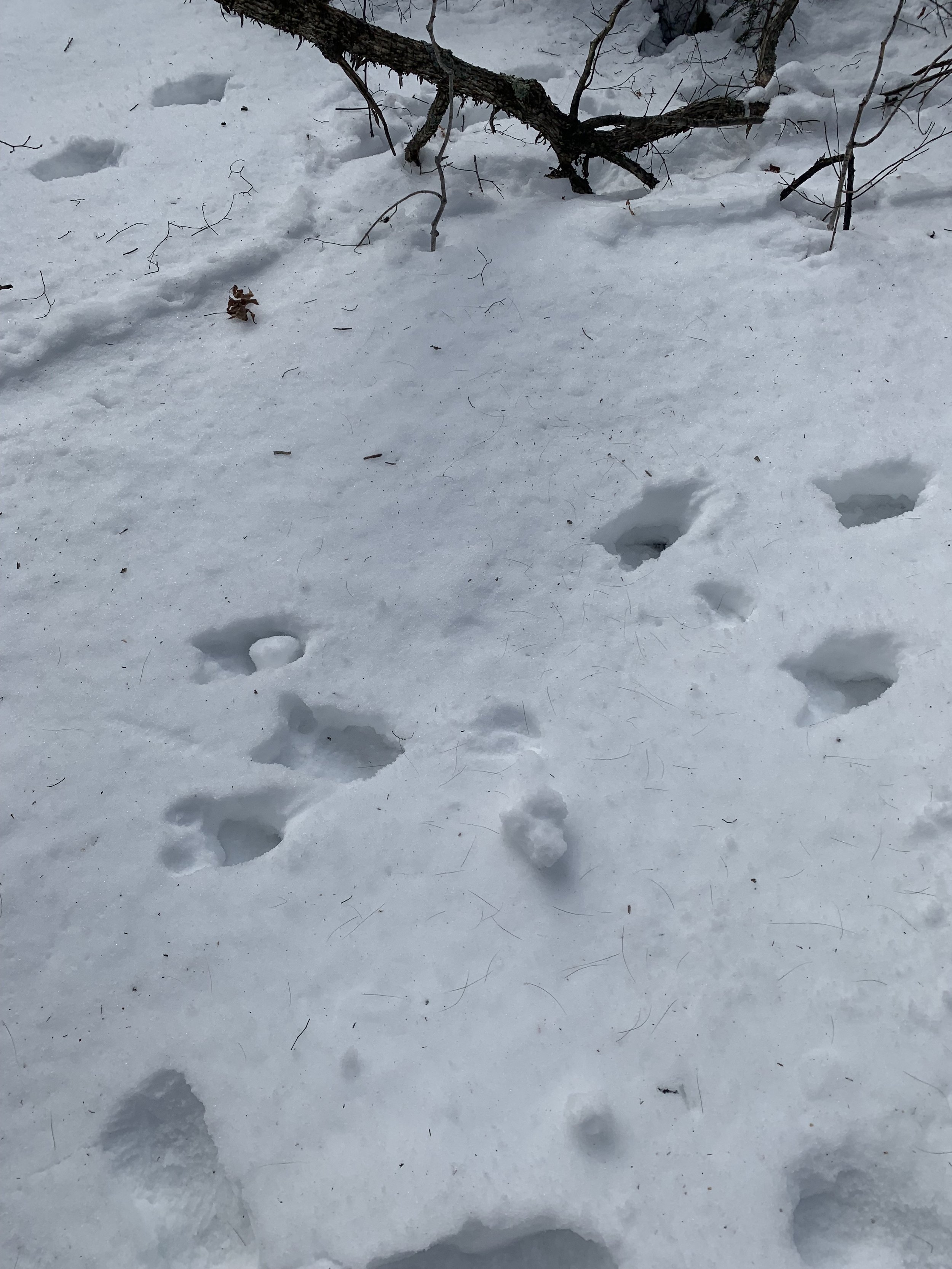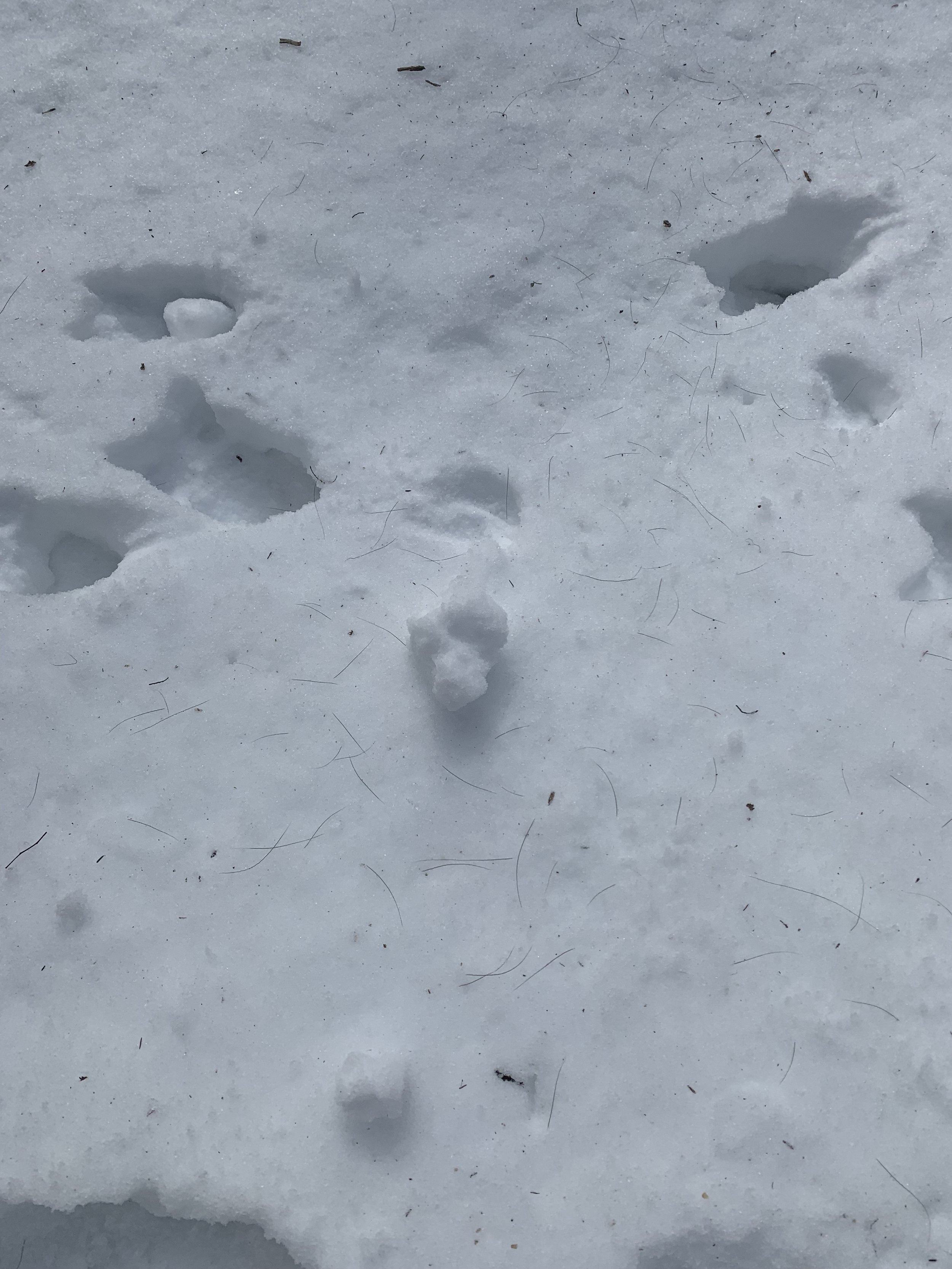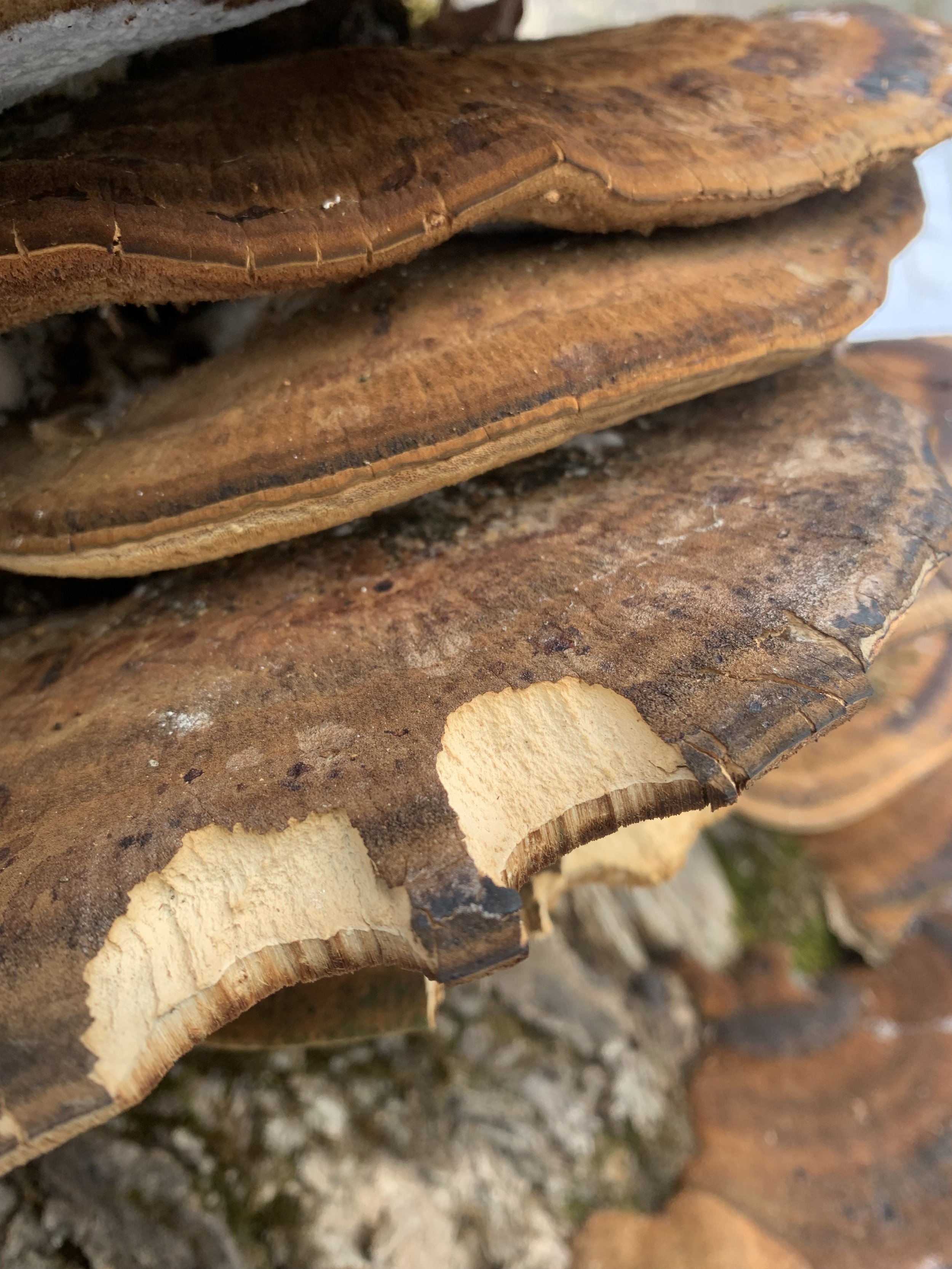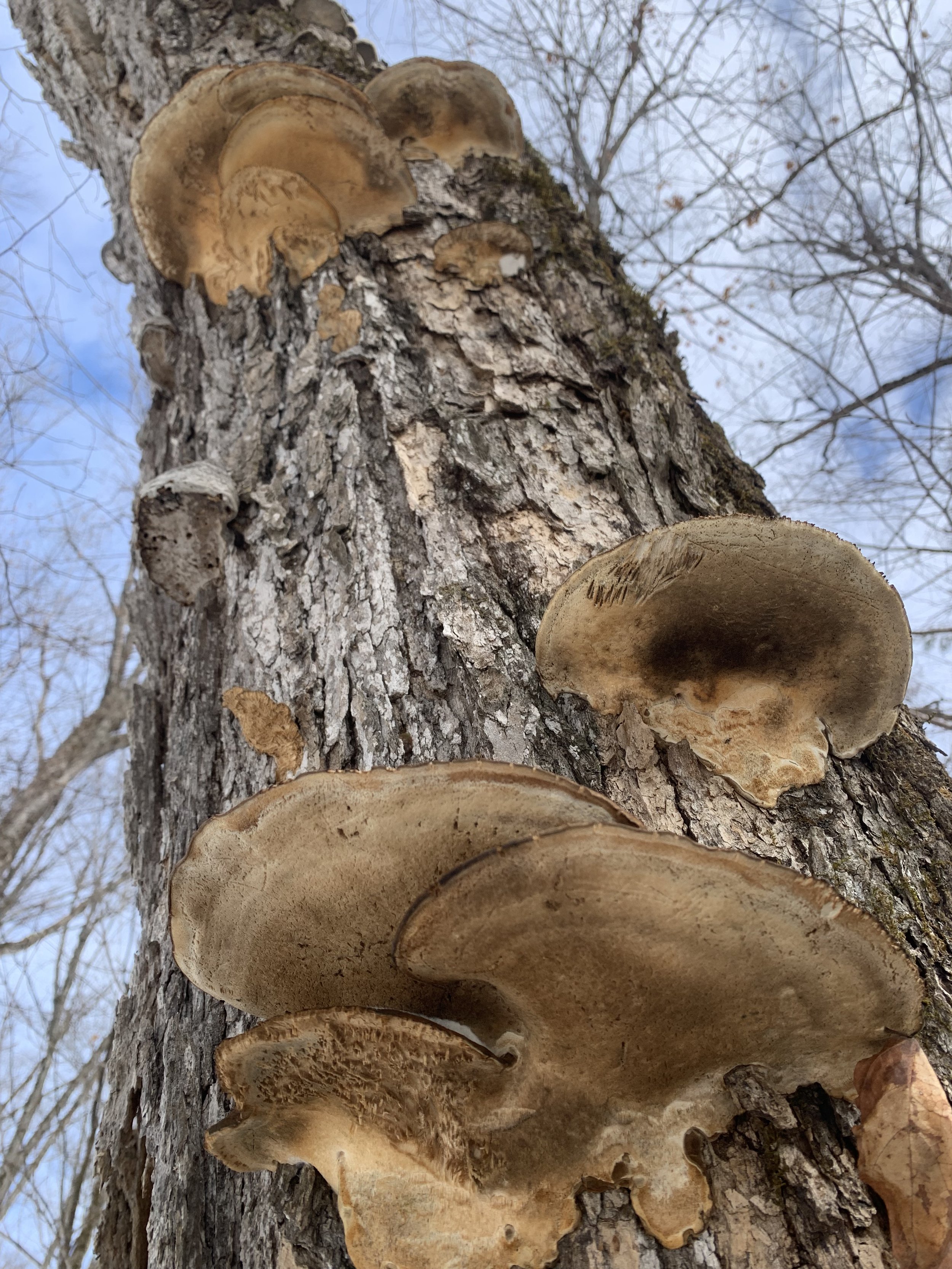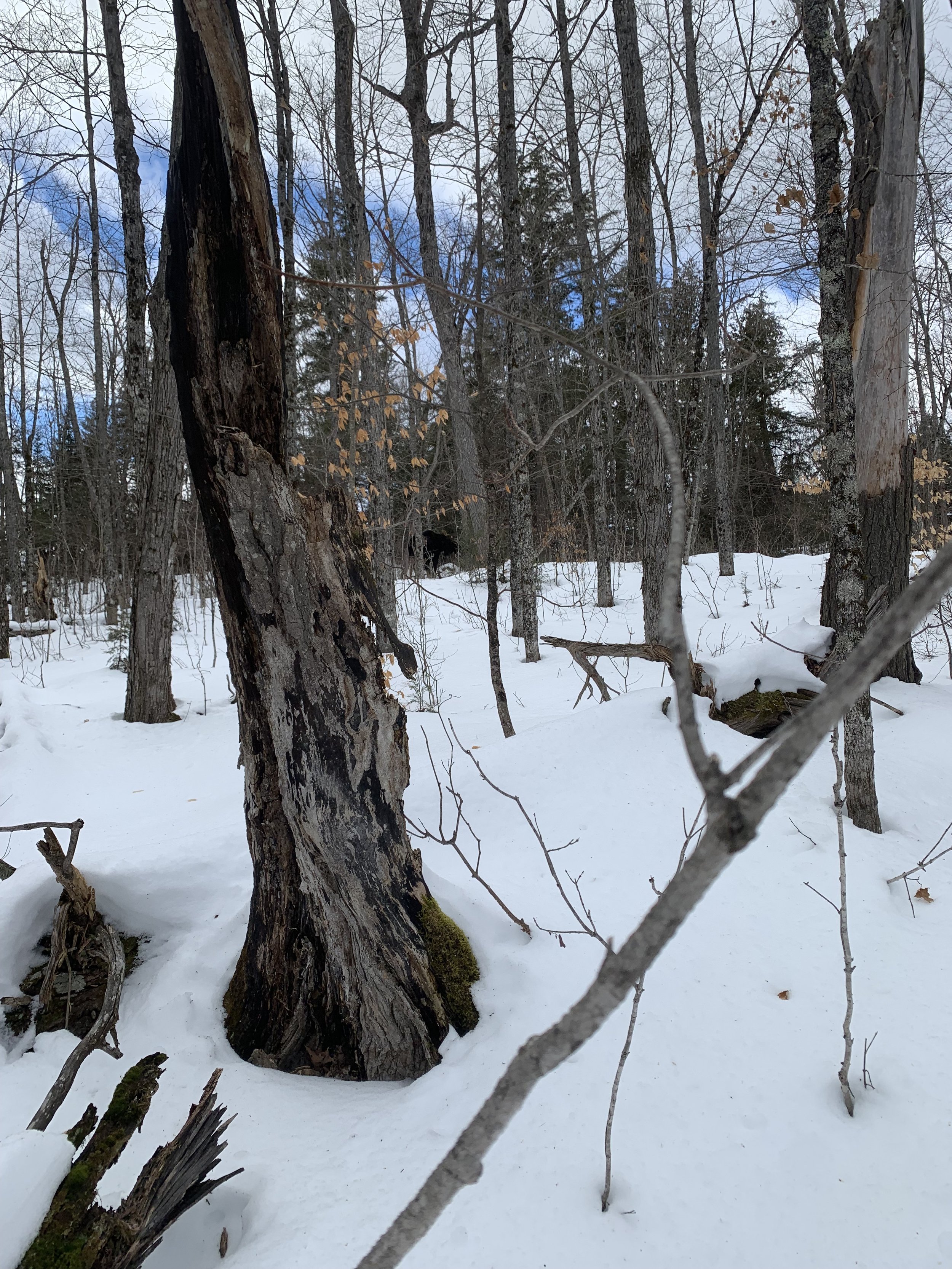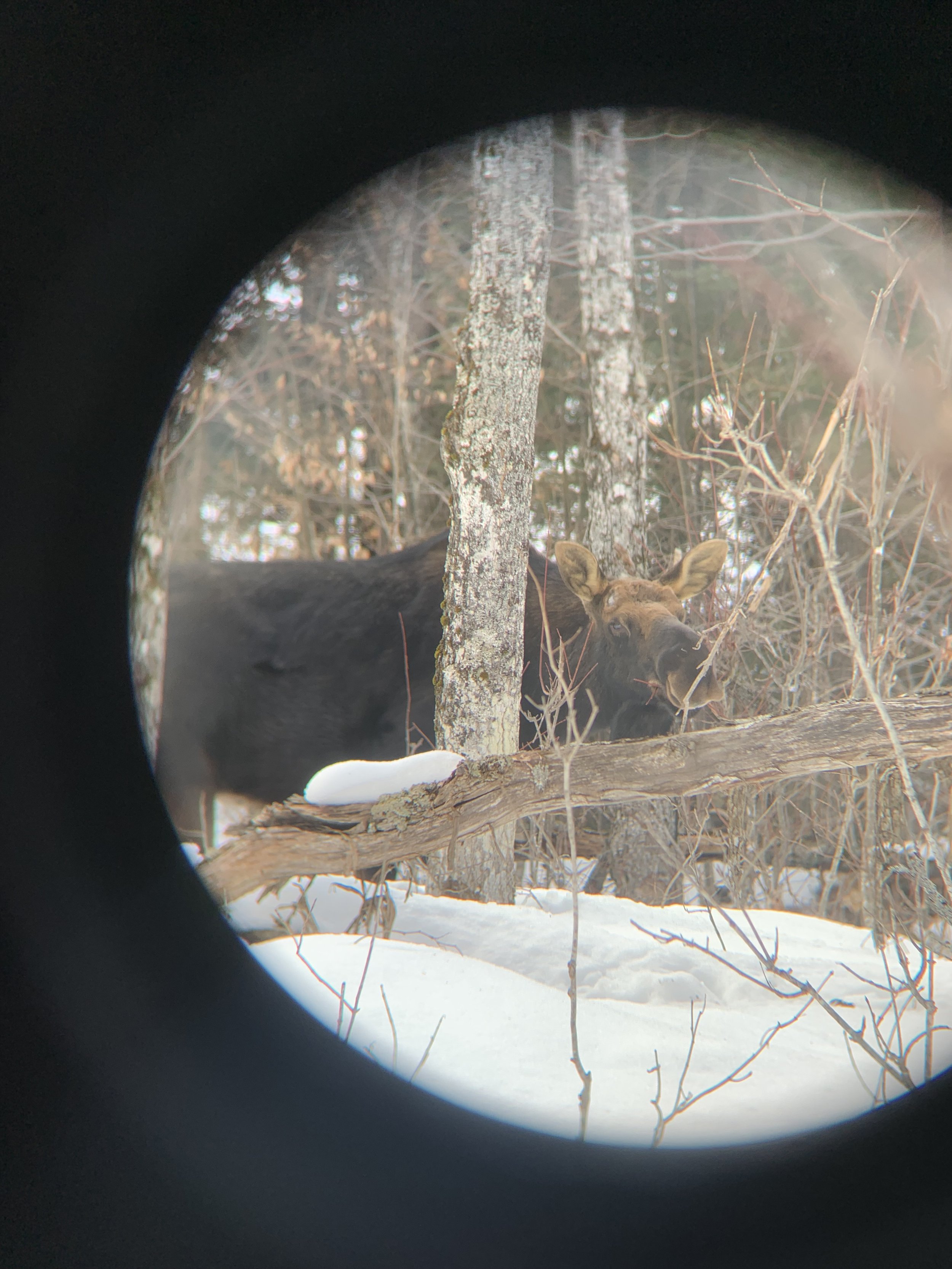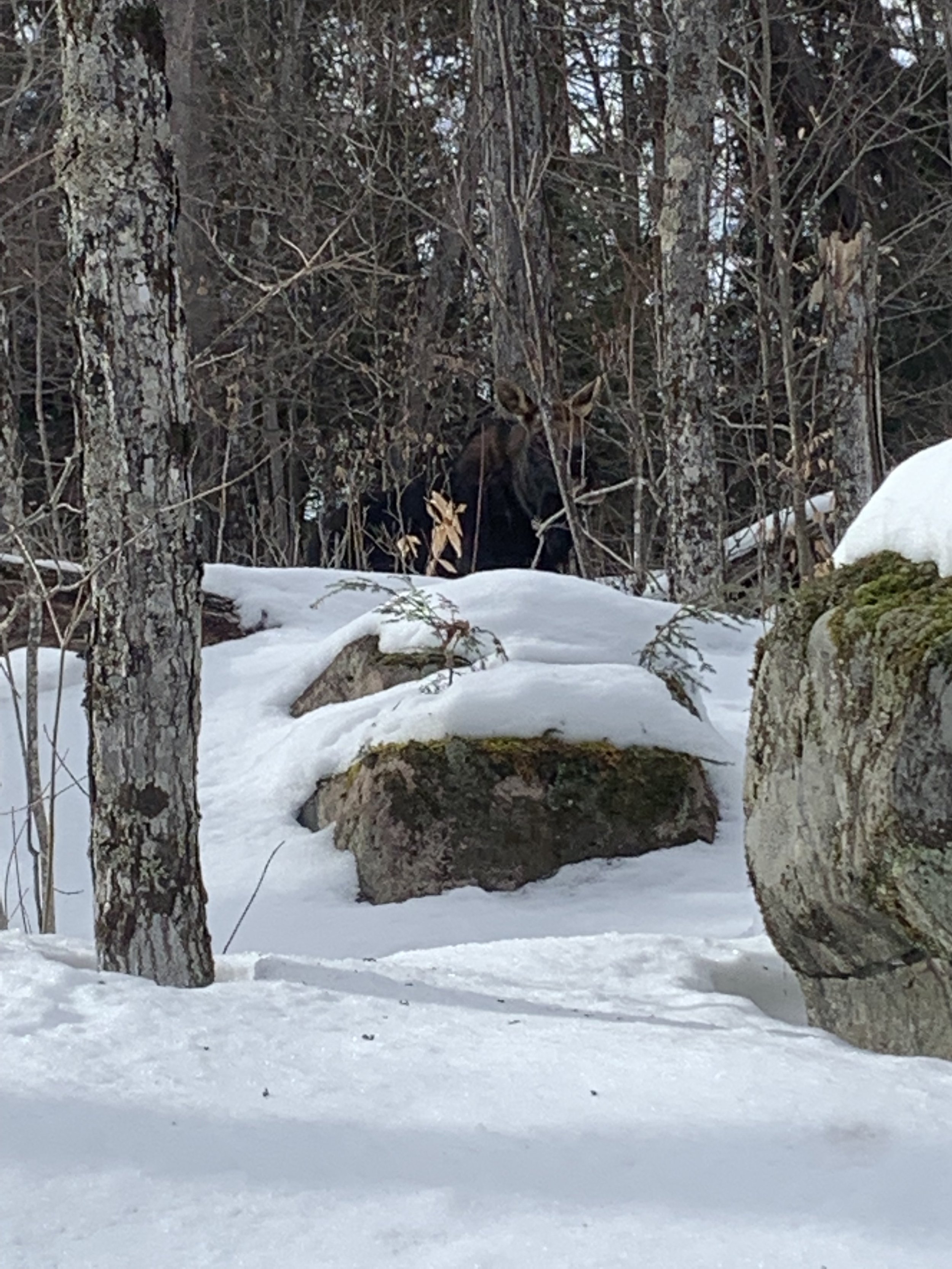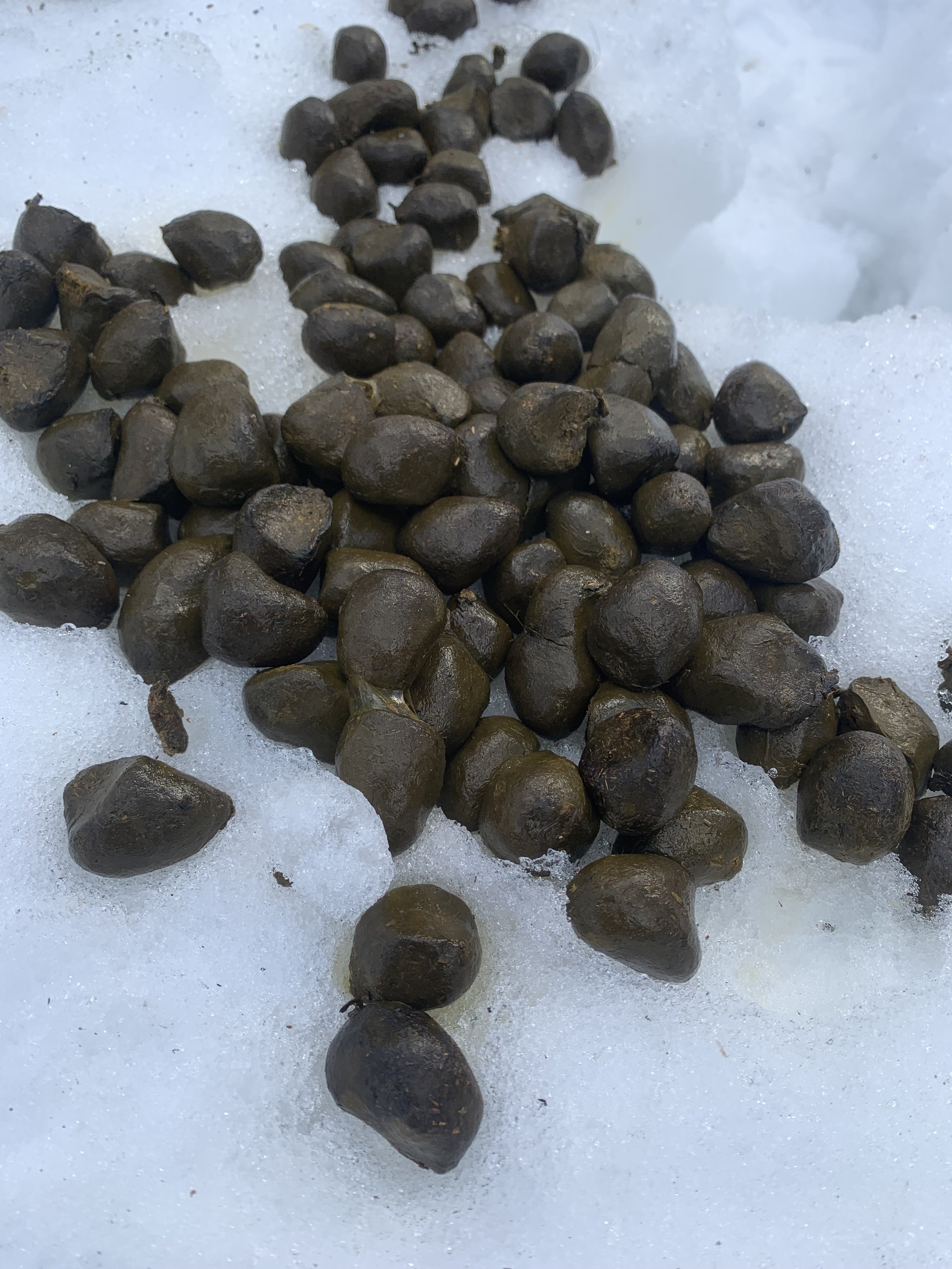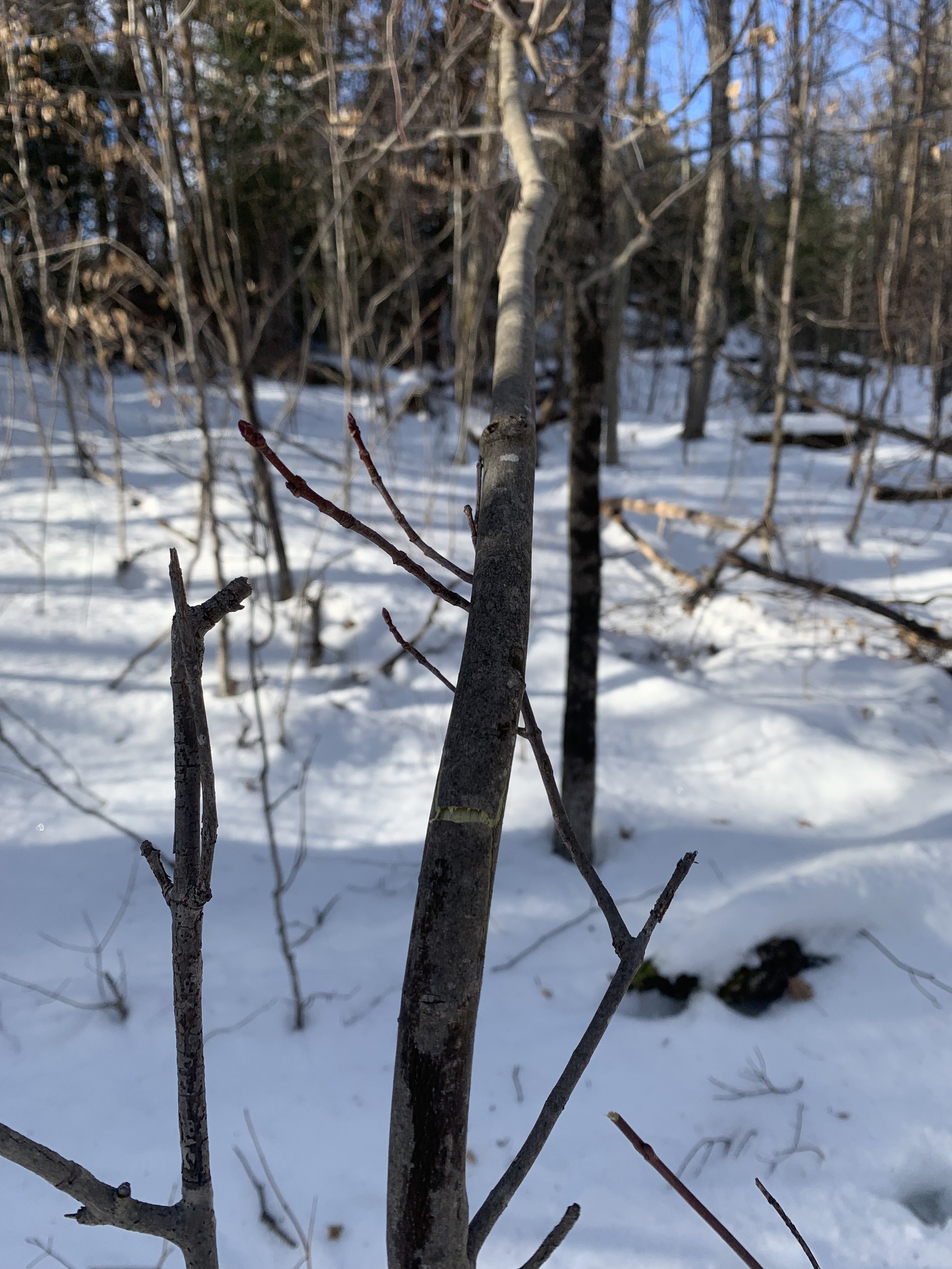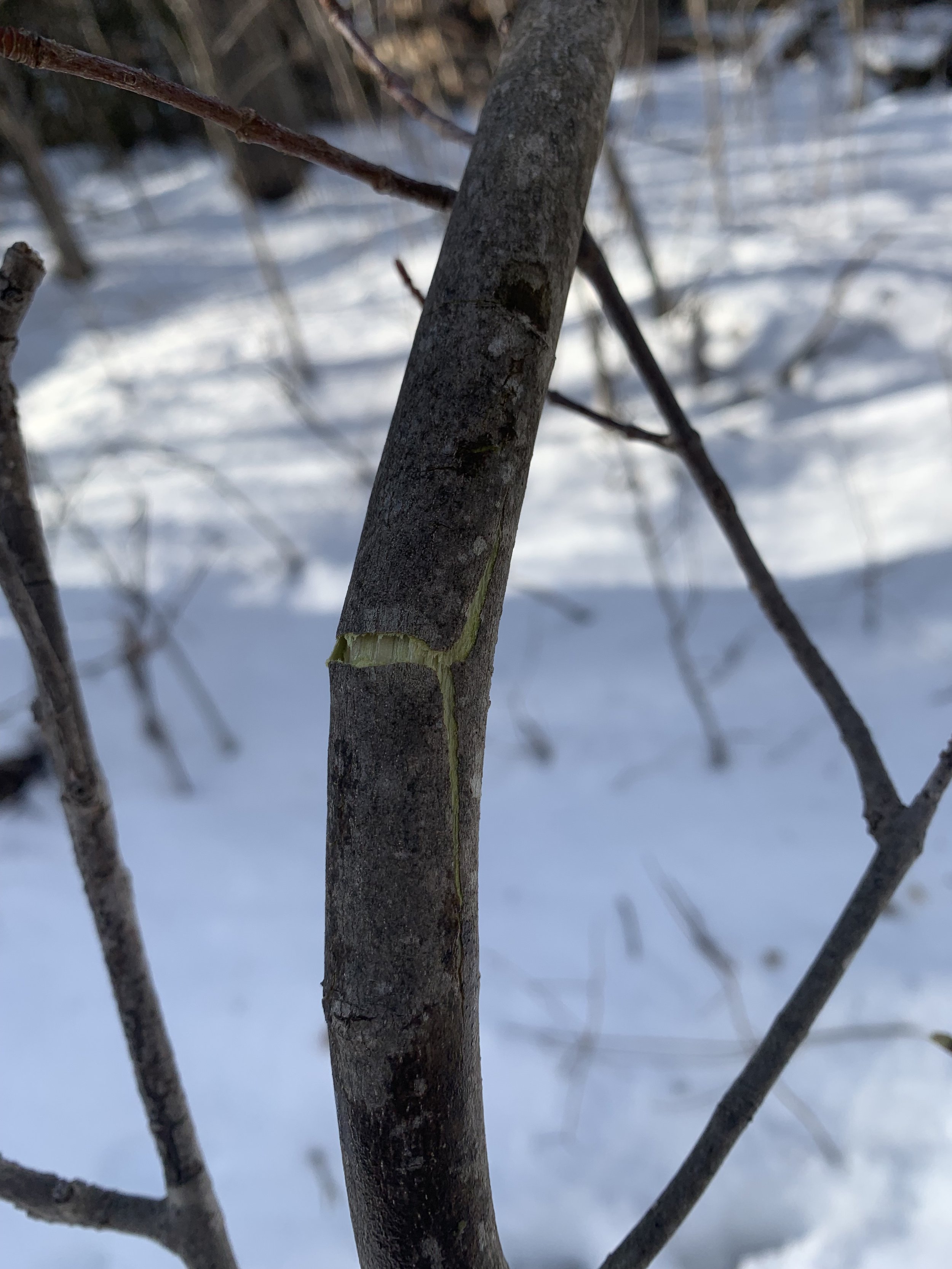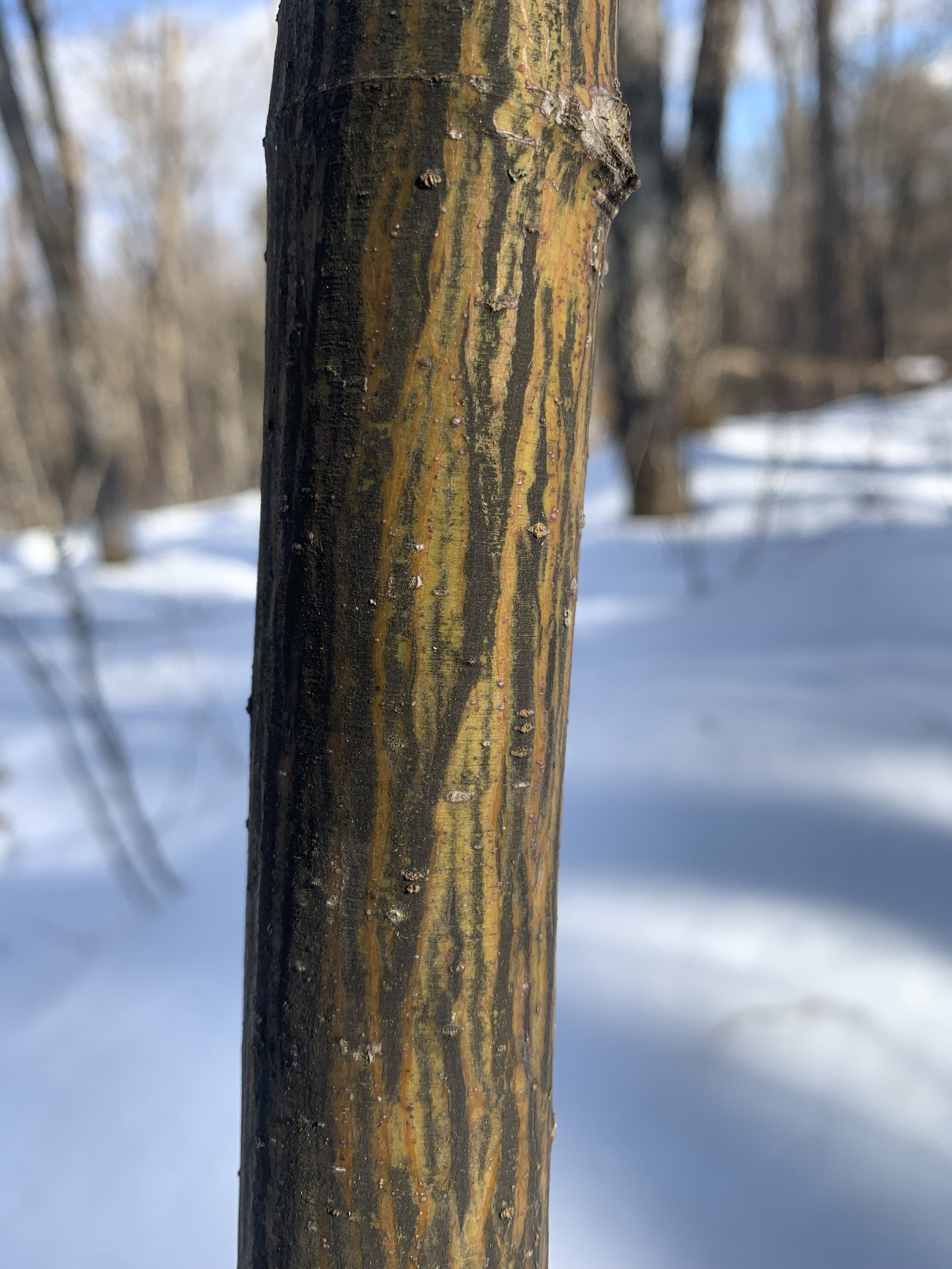5 Day Winter Wildlife Tracking in Algonquin Park with Earth Tracks: 2024
Monday February 12 -
Friday February 16,
2024
Live sighting & trailing a moose in ever-falling snow - tracks, scrapes, beds, scat, feeding sign, & seeing if we can’t catch up
Mouse, snowshoe hare, grouse, walking over the frozen lake, and tracking a pair of Pine Martens
Red Fox cache, flying squirrel sign, wolf tracks on the lake + inner child joy, & bear sign
Bat Lake, winter tooth-brushing, grouse, fox, marten & photography
Monday. February 12. 2024.
Day 1:
Live sighting & trailing moose; tracks, scat, feeding sign, scrapes, and getting up close
After a 4 hour drive from Guelph Ontario, this would be my 4th year up at the Wildlife Research Station in Algonquin Park for the weeklong Wildlife Tracking trip with Earth Tracks. This would also be my first week on my own without my son since coming out for this trip last year in 2023.
Dang, I really need to plan more time off from parenting…
Getting the day going
Being my 4th year attending this trip, I knew the drill. Scouting for tracks along highway 60 was at 7:00 am.
Yet for the first day, I opted to skip the scout, and take my time getting ready for the day, and instead, ease into the week and join the scouting the next day.
Alexis and Byron went to scout. Upon their return an hour later, they shared that they had found the one thing better then fresh tracks: a live sighting of a moose!
Everyone would drive East up the highway to trail the moose for the day.
Led by Alexis himself, with his trusty walking/tracking stick, Normon, Summer, and Malgosia make their way from the edge of the road up toward the tree line to pickup the moose trail.
The moose hair trail
This would not be my first time tracking moose, but it would be my first time consciously noticing that moose shed quite a bit of hair as they travel.
Can you spot the 3 moose hairs?
A close up of 2 other moose hairs. Perhaps not an easy thing to spot at first glance, but can become noticeable to the trained eye.
Notice the wavy or scriggly-ness of the hairs. Note as well the gradient colour change from almost colourless at the follicle, becoming white to grey-brown-black at the tapered end of the hair.
Size reference with my new Earth Tracks measuring device. Convenient for in the pocket for the wildlife tracker.
These moose hairs are about 4 - 4.5” in length. Size is important as it helps one to differentiate between species of ungulate, or hoofed mammals such as moose, or deer.
Moose tracks, and not the ice cream
A shot of a recently made moose hoof print with a tape measure for size reference. The far end of the tape measure goes all the way to the tip of the track where the tip of the hoof would have reached. From the end of the track to the dew claw print appears to be about 12” long.
Moose track with tape measure across the width of the track.
2 moose tracks in the snow, about 5 - 5 1/2” wide.
We made our way as a group through the forest following the moose tracks.
Shortly we came across a trodden walking trail. The trail itself was hardened snow, from normal human use. The moose tracks did not continue across the human trail, nor were the tracks evident on the hard path. But remember the moose hairs? Along the sides of the hard snow trail, there were moose hairs!
This is why it can be very smart to have more than one way of tracking an animals travel. The more types of sign or track that can be known, the better and easier the tracking will become. Especially if one way of tracking an animal is non-existent, or hard to find, you can simply go for another form of track or sign to follow.
In this case, it was hairs.
Following the hairs down the human path, the group soon came to a total stop.
An air of silence came upon everyone…
The group stopped along the path, looking out to where Alexis’s hand is gesturing, as the moose was closer than we realized.
After spending some time looking through the trees and through the binoculars to see the moose, the plan was to walk up the trail a bit further, to try to get a better look at the moose from a different angle, hopefully not spooking the moose in the process.
We took into consideration the direction of the wind, in relation to how our scent may travel towards the moose, in hopes to keep our presence off the moose radar as much as we could.
With Alexis at the front of the group, he led us slowly and quietly off the human path seeking a better vantage point.
Each person walked carefully in the foot prints of the person before them that were made in the snow. It was the type of snow that was crunchy and audible to step upon, unless you stepped in pre made foot steps.
It was a fun, but serious sneaking mission.
The new “spot” we stopped at to get a look at the moose.
The route Alexis took, traveled along side a set of older moose tracks, quite possibly the same moose, but from the day before. It is quite amazing to see how huge their steps are, walking as a human beside the tracks of a creature so grand and massive!
This track is a fresh moose track!
One can determine freshness, based on the look, sense, and even feel of the snow within and outside of the track.
Trail width
In the photos below, I took some time before joining the group to take some trail width measurements.
Trail width is what it sounds like, the width of a trail, in this case, that of the moose trail.
Trail width is a great tool to use to determine age, and or size of an animal.
It can also be used to compare with other trail widths of the same species, to differentiate individual animals.
For example, if there are 2 moose trails, one can measure trail width for both, and if you get different trail widths, it is likely that there are in fact 2 different moose. The bigger the trail width, usually indicates a bigger or older animal, and a smaller trail width would indicate a smaller animal.
This trail is also fresh from the day.
Moose x 2
The dark mass in the centre of this photo behind the trees, is the moose. Note the type of trees, if you can, as they are part of the reason for the moose being in this type of forest environment.
We spent a while speaking quietly to each other, and looking through binoculars at the moose.
It turned out that there wasn’t one, but two moose!
They both slowly made their way further from the humans starring at them through the trees, traveled up a hill, and out of our site. We decided to leave the moose to do their thing, and that we too, aught to also do our own human thing. The group headed over to where we had first initially spotted the first moose from the path, to check out what it had been up to.
Patterns and Imagination
This is what we found!
Here is a closer up shot of the above photo.
At first glance, one may simply see just tracks, and fur.
By spending more time looking at these tracks and fur, a whole story can be inferred. Of corse it can make things easier to have a few seasoned trackers with you. Yet all one really needs, is imagination and some logic.
A distinct pattern can be recognized in the above photos. A boxy shape, made by 4 tracks, creating almost, a rectangle.
What would cause an animal to create a boxy shape?
How would they behave?
What would they be doing?
Asking questions is fantastic way to start using ones imagination, and or logic, to begin putting the mystery together.
In this case, the moose was standing.
Standing still on all 4 legs, hence the 4 distinct tracks, creating that boxy, rectangular shape.
From this standing position, what we all came to infer, from simply taking time to ask questions, use our imagination, and putting our minds together, is that the moose came to a stop, then lifted hind foot, and scratched itself.
The scratching we came to due to the moose hairs scattered all over the ground.
The group had lunch, right beside the moose scratch spot, in the sunshine surrounded by hardwoods.
Squirrel feeding sign
At the lunch spot we noticed this old maple covered in mushrooms.
The mushrooms drew us all in, to discover some smaller sized signs from another creature.
There were even markings on the underside of the mushrooms from whomever enjoyed these mushrooms as food, perhaps a small climbing animal, such as a type of squirrel.
With lunch finished up, the plan for the remainder of the day was for the groups to branch off into 2 smaller groups.
Byron would lead one group, heading off from the moose trail. Alexis would lead the other, continuing after the freshly made moose trail. I opted to spend more time with the moose trail.
Following the fresh tracks, the small group wandered through the snow, and up that hill we had seen both of the moose travel up before lunch.
Upon reaching the top of this hill, we were amazed to discover that both of the moose had not made it as far as we had imagined, considering that a group of a dozen humans had just sat down and ate lunch.
Being a respectful visitor
One thing that started coming to mind, was what if the moose felt threatened and began charging at us? This was the second time now that we were graced with seeing these huge mammals up close.
I started imagining what I would do in the event the moose came at us.
Luckily, this never happened.
We were graced with a group of humans who all carried a lot of respect for animals and wildlife. The fact of the matter, was that we were in their home. We were but mere visitors in their home land, just watching these beings live life. If we were to be there and be that close, respect had to be at play. I began to theorize that perhaps the moose could sense this air of respect. We had zero intention of harming these mammals. If anything our intentions were quite the opposite, holding a sense of awe, and reverence. Perhaps these moose were letting us get this close. Or perhaps they were used to being around humans, or had some level of tolerance, considering how close to the road they had been since the 7 am scout, and how little they traveled from where we had seen them before lunch. Whatever it was, respect, awe, and reverence, were at play.
You know that feeling you get when your dewlap gets itchy? Me neither…
The moose that was in closest range.
Photo taken through binocular.
The second moose, a bit further away.
Based off the photos I took, the first one of the moose here being taken at 1:43 pm, and the last one at 2:07 pm, we had been in close quarters to these 2 animals for roughly 24 minutes.
The moose then slowly made their way into the woods, and out of our site. We left them to their business.
Thank you moose!
I don’t know about you, but it is not everyday that I am graced with seeing a wild animal, other than birds and squirrels, let alone something as massive as a moose, or even 2, moose.
The next best thing to seeing wildlife up close, is their tracks and sign.
Our small group, made their way over to where we had seen the moose just moments ago.
Upon reaching where we had seen the moose, we discovered a good amount of very fresh moose sign and tracks.
Scat and urine
These are not chocolates.
Possibly the freshest moose scat I’ve encountered.
Remember that boxy shape?
Here you may be able to notice that the moose was not scratching itself, as there is not much hair present.
However you may notice a different story based off the central hole in the snow, complete with some yellow snow.
I find it odd and interesting, how in the world tracking, something like poop and pee can be such a focal point of study.
There is so much to learn from what animals leave behind.
The more we notice, and the more we take time to be open to what we can learn, from even moose poop, the more knowledge we can be presented with about these amazing beings.
The other day I told the story of this moose pee to a groups of kids at an outdoor school I work at, and they just loved it!
Maybe because it is something relatable. We all go pee.
So when I explained to the kids about how you can tell gender of a moose based on how it peed, it was met with amazement and a “heck yes!!” type of response.
In that photo above, the spot where the pee ended up was in the middle of those 4 hoof prints.
This is indicative of a male moose, due to its reproductive parts. Remember, moose are mammals, and so are humans. Both types of male mammals have a penis. If you are a male human, think about how you go pee, and how that may appear in the snow.
A female moose, would be identified in a similar way, yet where the pee would land, would be between the tracks of the 2 hind hooves. Ladies, (human ladies) consider how you go pee, if you have ever peed outside, or in snow.
From what I understand, and for my own self, the pee usually lands between my foot prints.
Remember, this is not gross, its science, and tracking, and its cool.
The main difference is simply due to body anatomy.
Feeding sign
We know that all mammals must defecate (poop), and urinate (pee). Humans, and moose alike.
Something I have been finding more and more fascinating, is learning about wildlife, and comparing that knowledge with human life.
How we are similar, how we are different, and everything in between! There is quite a lot we as humans can learn, and directly apply to our own lives and ways of being, for our own betterment, from the world of wildlife.
Another thing we have in common with moose and wildlife, is eating!
A fresh break in a young maple tree.
One way moose access their food of choice.
Unlike humans, moose do not shop at stores, or grow their own vegetables, and I do not think, that they trade or barter…
I will have to look more into that though.
Close up of the break in the maple tree.
The feeding sign that we found was all on young maple trees. In the photos above, the moose had broken the tree, most likely using its body weight, so that it could access the maple buds growing higher up.
I don’t know about you, but to me that is absolute intelligence. Knowing the food one needs, how to attain it, and eating it.
And im not talking about the convenience of fast food joints.
The top of the young maple tree.
Notice the broken branches.
Close up of where the moose was nipping off and eating young growth and buds.
Alexis holding a branch the moose had bitten.
Close up shot of the trunk of a Striped Maple, also known as Moose wood, moose tree, or moose maple.
We did not find any of the same type of feeding sign on these types of maples as we found on the other maples that were pushed over, with broken branches, and eaten buds.
This tree is by far, one of my favourite trees!
Where I grew up and spent most of my years was in Southern Ontario, where this tree does not grow. When I make it to Algonquin Park for this tracking trip, the first time I cross the moose maple on this trip, I become excited! The type of feeling one gets when they see an old friend.
This year was the first time I began to learn a bit more about moose maple, and why it is called “moose” maple.
Above we learnt that moose eat buds from young maple trees as food, and they go after the moose maple for another reason. More on that in a moment.
Below: Young maple trees stunted by moose feeding on new growth.
Fresh and clear moose track in snow.
Some of the best things that can ever happen in life, I often find happen without any planning.
This is exactly what happened next.
The hoof print above was taken at the time of 3:04 pm, according to my iPhone.
The next few pictures were taken 3 minutes later, at, and just after 3:07 pm.
Since our last spotting of the moose, it had been about an hour. My last photo I had taken of the moose was taken at 2:07 pm, with the first photo of the 3 above being taken at 3:07pm.
A word of Safety
I want to name right away that I do not recommend folks go out and get this close to a moose.
These are wild animals in their home, literally on their own turf.
They are massive creatures, that could easily injure or even kill you if they wanted to.
Animals of this size, deserve our utmost respect.
We had spent roughly an hour mulling over moose scat, pee, tracks, and feeding sign in one general spot.
Little did we know that the 2 moose we had been seeing earlier on, had not moved as far away as we thought… nor that they were seemingly not that threatened by our noice levels, or presence.
It was only when we lifted our eyes and awareness from our moment of studiousness with the scat, pee and feeding sign, walked a few steps up a small hill, that we noticed right before us both moose were bedded down.
Before you watch the video below, I apologize for the amount of shakeyness and lack of stabilization.
An iPhone held up to binoculars is no easy feat.
I did learn on this trip however that they do make and sell a device to attach iPhones to ocular devices.
Until I get one myself, this is a good quick trick for a close up photo, if you have binoculars and a phone that takes photos, and less good without a tripod for a video.
As simple as it looks, the moose is laying down, eyes closed, chewing its cud. Notice too, that there are no antlers, but the area where they would have been is a darker brown coloured patch with white at the middle. I can definitely say I have never seen a moose bedded down, so close, so relaxed, with its eyes closed.
With a great sense of awe and reverence, for having been graced with such close proximity to these massive mammals, we spent about 10 minutes quietly watching the moose, and then opted to get off their turf.
Thank you moose!
Again, this is not common nor regular moose behaviour, for them to be so relaxed and unbothered by our presence. It is likely these are moose that are more used to humans than most, being this close to the main highway and trails of the park. Our small group of 5 was very mindful of being quiet, and very respectful. Please do not ever attempt to get this close to a moose. Although we were tracking moose, this final very close proximity experience was happen chance, and unintentional.
Our day was nearly done, when we came across some amazing moose sign on a moose maple tree.
Moose medicine
We were no match for passing up some fresh scrapes.
Alexis shared that moose seek out the moose maple, for its bark. The stripy appearance of the bark, correlates to what is known as the doctrine of signatures. This refers to plants or things that have resemblance to body parts, in relation to nutritional or medicinal functions. For the moose maple, it correlates to veins, or varicose veins. If a moose for example is hit by a vehicle, or takes damage to its body, it may seek out moose maple bark for medicinal value in healing bruises. The process of creating new blood vessels is stimulated through angiogenesis.
I don’t know about you, but I for one want to be more like a moose. Knowing what plants or trees hold the right medicine I need, and where to find it.
Id love to know the active compounds in the bark itself. After doing some research on this, I have yet to find anything specifically about what that is. If you know about moose maple bark, and what it is that stimulates angiogenesis, please share in the comments.
Soon we made our way back to the parking lot where we had began our day.
Our cups feeling full of reverence, adventure, and moose tracking.
Back at the WRS, we would fill our physical cups with hot tea, along with lots of feild guides, and follow up research.
Thank you for reading Day 1!
Feel welcome to leave a comment, correct any information, or share facts and stories related in the comments below
Check out Day 2 of the trip below:
Trailing live sighting of a moose, learning its tracks & sign in falling snow, and seeing if we can’t catch up




